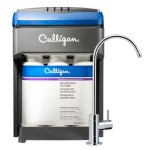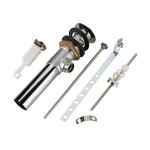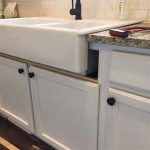Musty Smell From Kitchen Sink Drain: Causes and Solutions
A musty smell emanating from the kitchen sink drain is a common household problem. This unpleasant odor can permeate the kitchen and, in some cases, the entire home. Identifying the source of the smell and implementing effective solutions is crucial for maintaining a clean and healthy living environment. Understanding the underlying causes and applying appropriate remedies can effectively eliminate the musty odor and prevent its recurrence.
The kitchen sink drain is prone to collecting organic matter, grease, and food particles. These materials decompose over time, creating an ideal breeding ground for bacteria and mold. The resulting microbial activity produces volatile organic compounds (VOCs) that are responsible for the musty, sometimes rotten-egg-like, odor. Ignoring this issue can lead to further problems, including persistent smells, potential health concerns, and even drain clogs.
Biofilm Formation and Decomposition
Biofilm, a complex community of microorganisms, is a primary contributor to musty smells in kitchen sink drains. This slimy layer forms on the interior surfaces of the drainpipe and the P-trap, where water and organic debris accumulate. Bacteria, fungi, and other microorganisms within the biofilm break down the trapped matter, releasing foul-smelling gases such as hydrogen sulfide, ammonia, and methane. The composition of the biofilm varies depending on the types of food waste and other substances that regularly enter the drain.
Decomposition of food particles is accelerated in the warm, moist environment of the drain. Fats, oils, and grease (FOG) solidify and cling to the pipe walls, further trapping debris and fostering bacterial growth. Starchy foods, such as rice and pasta, can also contribute to the problem, as they readily ferment and produce unpleasant odors. Over time, the accumulation of decomposing organic matter creates a persistent source of foul smells that can be difficult to eliminate without thorough cleaning.
The effectiveness of various cleaning methods depends on the specific composition and extent of the biofilm. Simple flushing with hot water may provide temporary relief but will not eradicate the underlying microbial colonies. Stronger chemical cleaners or enzymatic drain cleaners are often necessary to break down the biofilm and remove the accumulated organic matter. Regular preventative maintenance, such as flushing the drain with boiling water and baking soda, can help inhibit the formation of biofilm and reduce the likelihood of musty odors.
Additionally, dish soap residue can contribute to biofilm formation. While dish soap is intended to clean, some formulations contain ingredients that, when combined with hard water or other minerals, can create a sticky film on the drainpipe walls. This film then becomes a breeding ground for bacteria and organic matter. Using a high-quality dish soap and thoroughly rinsing dishes before placing them in the dishwasher can help minimize the build-up of this residue.
The Role of the P-Trap
The P-trap is a U-shaped section of pipe located under the sink. Its primary function is to trap a small amount of water that creates a barrier, preventing sewer gases from entering the home. However, the P-trap can also become a reservoir for food particles, grease, and other debris. The stagnant water in the P-trap provides an ideal environment for bacterial growth and decomposition, contributing significantly to musty odors.
If the P-trap is not functioning correctly, such as if it is dry due to infrequent use or a leak, sewer gases can escape into the kitchen. Sewer gases contain a variety of compounds, including methane, hydrogen sulfide, and ammonia, which can produce a strong, unpleasant odor that is often described as rotten eggs or sewage. Regularly checking the P-trap to ensure it contains water is essential for preventing sewer gas leaks.
Cleaning the P-trap is a relatively straightforward process that can effectively eliminate musty odors. This involves disconnecting the P-trap from the drainpipes, emptying its contents, and thoroughly cleaning the interior with a brush and soapy water. Careful attention should be paid to removing any accumulated debris or sludge. After cleaning, the P-trap should be reassembled tightly to prevent leaks.
In some cases, the P-trap itself may be damaged or corroded, leading to leaks or poor drainage. If the P-trap shows signs of damage, such as cracks or excessive rust, it should be replaced. Installing a new P-trap is a relatively inexpensive and simple task that can significantly improve the overall performance of the drain and eliminate odor problems.
Furthermore, proper ventilation of the plumbing system is crucial for preventing the buildup of sewer gases. A vent pipe, typically located on the roof, allows air to enter the drain system, ensuring that the P-traps remain filled with water and preventing the formation of a vacuum that could suck water out of the traps. If the vent pipe is blocked or damaged, sewer gases can back up into the home. A professional plumber can inspect the vent pipe and clear any blockages or make necessary repairs.
Addressing Drain Blockages and Slow Drainage
Drain blockages and slow drainage are often underlying causes of musty smells in kitchen sinks. When the drain is partially blocked, water and debris accumulate, providing a breeding ground for bacteria and mold. The resulting decomposition produces foul-smelling gases that emanate from the drain.
Common causes of drain blockages include accumulations of food particles, grease, hair, and soap scum. These materials can gradually build up over time, restricting water flow and creating stagnant pools where bacteria thrive. Regular flushing of the drain with hot water and baking soda can help prevent blockages by dissolving grease and loosening accumulated debris.
If a drain is significantly blocked, more aggressive measures may be necessary. A plunger can be used to dislodge the blockage by creating pressure and forcing water through the drain. A drain snake, a flexible tool designed to reach deep into the drainpipe, can be used to break up or retrieve the blockage. Chemical drain cleaners can also be used, but they should be used with caution, as they can be corrosive and damage pipes if used improperly.
Enzymatic drain cleaners offer a more environmentally friendly alternative to chemical drain cleaners. These cleaners contain enzymes that break down organic matter, such as food particles and grease, without harming the pipes. Enzymatic cleaners are particularly effective for preventing the buildup of biofilm and maintaining a clean drain.
Preventative measures are key to avoiding drain blockages and the associated musty smells. Avoiding the disposal of large quantities of food waste, grease, and coffee grounds down the drain can significantly reduce the risk of blockages. Installing a drain strainer can also help catch solid debris, preventing it from entering the drainpipe. Regular maintenance, such as flushing the drain with hot water and baking soda, is essential for keeping the drain clean and odor-free.
In cases of severe drain blockages or persistent musty smells, it may be necessary to consult with a professional plumber. A plumber can use specialized equipment, such as a video camera, to inspect the drainpipe and identify the source of the blockage. They can also use high-pressure water jetting to thoroughly clean the drainpipe and remove any accumulated debris. Addressing drain blockages promptly and effectively is crucial for maintaining a healthy and odor-free kitchen.

Deodorize A Kitchen Sink That Smells 5 Ways Youtube

How To Remove Musty Odors From Kitchen Sink Water Damage

How To Remove Sink Odor With Baking Soda And Vinegar Zep Drain Defense Prevent

How To Clean A Stinky Sink Drain

How To Clean A Smelly Drain Easy Diy Fixes For Foul Odors

Why Is There A Smell Under My Sink

Unpleasant Drain Odor Identifying The Offenders

Stinky Sink Here S What Causes A Foul Drain Smell

How To Remove Sink Odor With Baking Soda And Vinegar Zep Drain Defense Prevent Youtube

How To Clean A Smelly Drain Liquid Plumr







